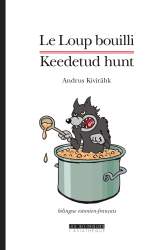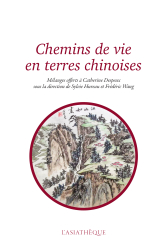Details
Format: Paperback
ISBN: 9782901795988
Collection: Hors Collection
13.5 x 21.5 cm
Weight: 400 gr
Pages: 264
First publication: 05/10/1995
CLIL: 3372
BISAC: PHI005000
Les piliers du destin
La chronomancie, expression de la vision chinoise du monde
In this text, the author digs deeper into the research upon which he based his previous text, Les huit signes de votre destin (The Eight Signs of Your Destiny), published by L'Asiathèque and now out of print. This text explains the rules around which the horoscopes are founded, and exposes the principles which govern Chinese divination. A reference book which illuminates various aspects of Chinese thought. It includes numerous black and white photos.
CONTRIBUTORS' BIOGRAPHIES
Jean-Michel de Kermadec
Jean-Michel de Kermadec was secretary to Father Teilhard de Chardin and professor at Aurore University in Shanghai.
TABLE OF CONTENTS
Frontispice : calligraphie de Yu Qilong (Odilon) (Frontispiece: calligraphy by Yu Qilong (Odilon))
Préface de Jean Lartéguy (Preface by Jean Lartéguy)
Avant-propos (Foreword)
Introduction (Introduction)
PREMIÈRE PARTIE: La mentalité chinoise (PART ONE: The Chinese mentality)
Chapitre 1 : Le contexte chinois (Chapter 1: The Chinese Context)
Les données fondamentales (Fundamental data)
Les fondements de la morale (Foundations of Morality)
Le refus obstiné de toute idéologie (The stubborn rejection of any ideology)
Valeur de la connaissance (Value of knowledge)
De la relativité du discours (Relativity of discourse)
La relation de l'homme à l'univers : l'essentiel art de vivre (Man's relationship to the universe: the essential art of living)
De la religion (Religion In short)
En résumé (Religion In short)
Chapitre 2 : Culture et tradition orale (Chapter 2: Culture and Oral Tradition)
Origine du langage (Origin of the language)
La valeur du langage : le nom (The value of the language: the name)
Les deux modes de connaissance (The two modes of knowledge)
Intelligence et mémoire (Intelligence and memory)
L'imaginaire (The imagination)
Mémoire et tradition orale (Intelligence and memory)
Chapitre 3 : Les clefs de l'écriture (Chapter 3: The Keys to Writing)
Symbolisme et magie de l'idéogramme (Symbolism and magic of the ideogram)
Du langage à l'écriture (From language to writing)
Les différents types d'écriture Histoire de l'écriture chinoise (The different types of writing History of Chinese)
Caractéristiques de l'écriture sur os divinatoires (Features of writing on divinatory bones)
De la calligraphie (Calligraphy)
L'écriture dans la Chine d'aujourd'hui (Writing in Today's China)
De l'écriture phonétique et de la romanisation (Phonetic writing and romanization)
Dernier avatar de la langue chinoise : le pinyin (Last avatar of the Chinese language: pinyin)
En guise de conclusion (By way of conclusion)
Chapitre 4 : Importance primordiale de la divination (Chapter 4: Primordial Importance of Divination)
Aperçu historique (Historical overview)
La divination est un acte essentiellement moral (Divination is an essentially moral act)
L'homme dans l'univers (Man in the universe)
Valeur et limites de la divination : la scapulomancie / l'achillée / l'horoscope (Value and limits of divination: scapulomancy / yarrow / horoscope)
La divination chinoise : l'astrologie proprement dite / autres méthodes de divination (Chinese divination: astrology itself / other methods of divination)
Conclusion (Conclusion)
Le Livre des Mutations (Yi King ou Yijing) (The Book of Mutations (Yi King or Yijing))
DEUXIÈME PARTIE: Signes et symboles de l'espace-temps (PART TWO: Signs and symbols of space-time)
Chapitre 5 : Mise en place spatio-temporelle (Chapter 5: Spatio-temporal implementation)
Le culte du ciel (The cult of heaven)
Le double temple du ciel : Le Tertre du Sud / Le Temple du Nord (The double temple of heaven: The Tertre of the South / The Temple of the North)
Chapitre 6 : Du calendrier (Chapter 6: Calendar)
L'impossible harmonisation du calcul (The impossibility of harmonizing the calculation)
Le calendrier astrologique (The astrological calendar)
Les saisons et les mois zodiacaux (Zodiac seasons and months)
Les saisons et les mois astrologiques en Chine (Astrological seasons and months in China)
Les vingt-quatre termes solaires (The twenty-four solar terms)
Chapitre 7 : Les almanachs (Chapter 7: Almanacs)
Les almanachs : L'édition actuelle de l'almanach / le calendrier privé de l'empereur / le calendrier d'acupuncture (Almanacs: The current edition of the almanac / the emperor's private calendar / the acupuncture calendar)
La définition du temps - le système courant de datation (The definition of time - the current dating system)
TROISIÈME PARTIE : Les techniques divinatoires (PART THREE: Divinatory techniques)
Chapitre 8 : Les piliers, les troncs et les rameaux (Chapter 8: Pillars, Trunks and Twigs)
Le cycle sexagésimal (The sexagesimal cycle)
La découverte des autre piliers ou huit signes du destin (The discovery of the other pillars or eight signs of destiny)
Les caractères cycliques et leur histoire : Les dix Troncs célestes / Les douze Rameaux terrestres Relations entre signes des cycles dénaire et duodénaire (Cyclic characters and their history: The Ten Celestial Trunks / The Twelve Earthly Branches Relations between signs of the dene and duodene cycles)
Les relations secrètes entre Rameaux terrestres et Troncs célestes (The Secret Relationship Between Earthly Palms and Celestial Trunks)
Chapitre 9 : Les cinq agents (Chapter 9: The Five Officers)
Nature des cinq agents (Nature of the five agents)
Affinités et relations des cinq agents (Affinities and relationships of the five agents)
Relations entre les piliers et les agents (Relationships between pillars and agents)
Le rythme du temps, les alternances du Yin et du Yang : les cinq agents et les quatre saisons / les cinq agents, le Yin et le Yang, et les heures / Les cinq agents et le langage des sociétés secrètes (The rhythm of time, the alternations of Yin and Yang: the five agents and the four seasons / the five agents, the Yin and the Yang, and the hours / The five agents and the language of secret societies)
Chapitre 10 : Le bestiaire emblématique (Chapter 10: The Iconic Bestiary)
Les douze animaux zodiacaux : l'interprétation populaire / l'interprétation traditionnelle (The Twelve Zodiacal Animals: The Popular Interpretation / Traditional Interpretation)
Relations entre les douze animaux (Relations between the twelve animals)
Chapitre 11 : Les vingt-huit constellations (Chapter 11: The Twenty-Eight Constellations)
Les vingt-huit constellations demeures de la lune Les vingt-huit constellations et la semaine (The twenty-eight constellations and the week)
Chapitre 12 : Horoscope des quatre piliers (Chapter 12: Horoscope of the Four Pillars)
Établissement des données : l'année / le mois / le jour / l'heure Les binômes : généralités / les signes ou piliers Calcul des binômes : calcul du binôme annuel / calcul du binôme mensuel / calcul du binôme journalier / calcul du binôme de l'heure (Establishment of data: year / month / day / time Pairs: generalities / signs or pillars Calculation of binomials: calculation of the annual binomial / calculation of the monthly binomial / calculation of the daily binomial / calculation of the hour binomial)
QUATRIÈME PARTIE: La chronomancie (PART FOUR: Chronomancy)
Chapitre 13 : La chronomancie et les soixante piliers (Chapter 13: Chronomancy and the Sixty Pillars)
Le chant mnémonique des soixante binômes (The mnemonic song of the sixty pairs)
Premier et Deuxième piliers (First and Second Pillars)
Troisième et Quatrième piliers (Third and Fourth Pillars)
Cinquième et Sixième piliers (Fifth and Sixth Pillars)
Septième et Huitième piliers (Seventh and Eighth Pillars)
Neuvième et Dixième piliers (Ninth and Tenth Pillars)
Onzième et Douzième piliers (Eleventh and Twelfth Pillars)
Treizième et Quatorzième piliers (Thirteenth and Fourteenth Pillars)
Quinzième et Seizième piliers (Fifteenth and Sixteenth Pillars)
Dix-septième et Dix-huitième piliers (Seventeenth and Eighteenth Pillars)
Dix-neuvième et Vingtième piliers (Nineteenth and Twentieth Pillars)
Vingt-et-unième et Vingt-deuxième piliers (Twenty-first and Twenty-second pillars)
Vingt-troisième et Vingt-quatrième piliers (Twenty-third and Twenty-fourth pillars)
Vingt-cinquième et Vingt-sixième piliers (Twenty-fifth and Twenty-sixth pillars)
Vingt-septième et Vingt-huitième piliers (Twenty-seventh and Twenty-eighth pillars)
Vingt-neuvième et Trentième piliers (Twenty-ninth and Thirtieth pillars)
Trente-et-unième et Trente-deuxième piliers (Thirty-first and Thirty-second pillars)
Trente-troisième et Trente-quatrième piliers (Thirty-third and Thirty-fourth pillars)
Trente-cinquième et Trente-sixième piliers (Thirty-fifth and Thirty-sixth pillars)
Trente-septième et Trente-huitième piliers (Thirty-seventh and Thirty-eighth pillars)
Trente-neuvième et Quarantième piliers (Thirty-ninth and Fortieth pillars)
Quarante-et-unième et Quarante-deuxième piliers (Forty-first and Forty-second pillars)
Quarante-troisième et Quarante-quatrième piliers (Forty-third and Forty-fourth pillars)
Quarantième-cinquième et Quarantième-sixième piliers (Fortieth-fifth and Fortieth-sixth pillars)
Quarantième septième et Quarantième-huitième piliers (Fortieth seventh and fortieth-eighth pillars)
Quarante-neuvième et Cinquantième piliers (Forty-ninth and Fiftieth pillars)
Cinquante-et-unième et Cinquante-deuxième piliers (Fifty-first and Fifty-second pillars)
Cinquante-troisième et Cinquante-quatrième piliers (Fifty-third and Fifty-fourth pillars)
Cinquante-cinquième et Cinquante-sixième piliers (Fifty-fifth and Fifty-sixth pillars)
Cinquante-septième et Cinquante-huitième piliers (Fifty-seventh and Fifty-eighth pillars)
Cinquante-neuvième et Soixantième piliers (Fifty ninth and sixtieth pillars)
Chapitre 14 : La chronomancie populaire (Chapter 14: Popular Chronomancy)
Les douze animaux : le rat / le buffle / le tigre / le lièvre / le dragon / le serpent / le cheval / le bélier / le singe / le coq / le chien / le cochon (The twelve animals: the rat / the buffalo / the tiger / the hare / the dragon / the snake / the horse / the ram / the monkey / the rooster / the dog / the pig)
Chapitre 15 : La chronomancie et les astres (Chapter 15: Chronomancy and the stars)
Les cinq planètes et leurs interprétations (The five planets and their interpretations)
Les vingt-huit constellations (The twenty-eight constellations)
Le chant des quatre saisons (The song of the four seasons )
Horoscope chinois et relations humaines (Chinese horoscope and human relations)
Relations entre les agents dominants (Relationships between dominant agents)
Chapitre 16 : Relation entre la chronomancie et la numérologie (Chapter 16: Relationship between chronomancy and numerology)
La numérologie (Numerology)
Appendice 1 : Les jeux du Yin et du Yang (Appendix 1: The Games of Yin and Yang)
Appendice 2 : La boussole et la géomancie en Chine (Appendix 2: The Compass and Geomancy in China)
Bibliographie (Bibliography)
Glossaire (Glossary)
Comment monter son thème (How to mount your theme)
Méthode simplifiée de calcul des piliers (Simplified method of calculating pillars)
Un exemple d'horoscope informatique (An example of a computer horoscope)














